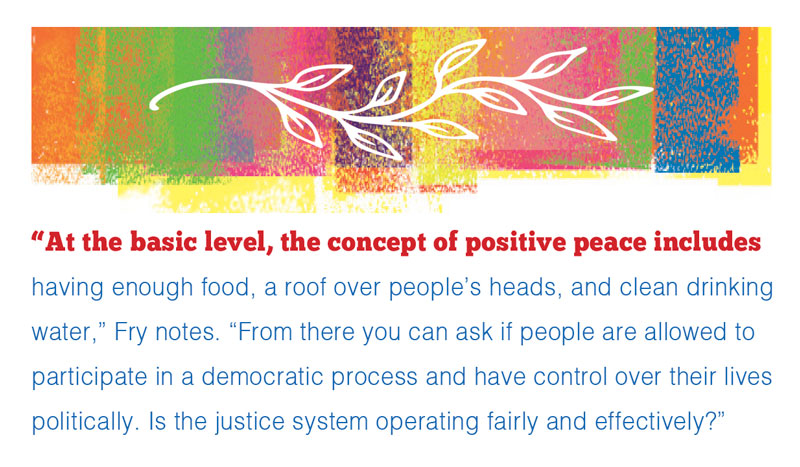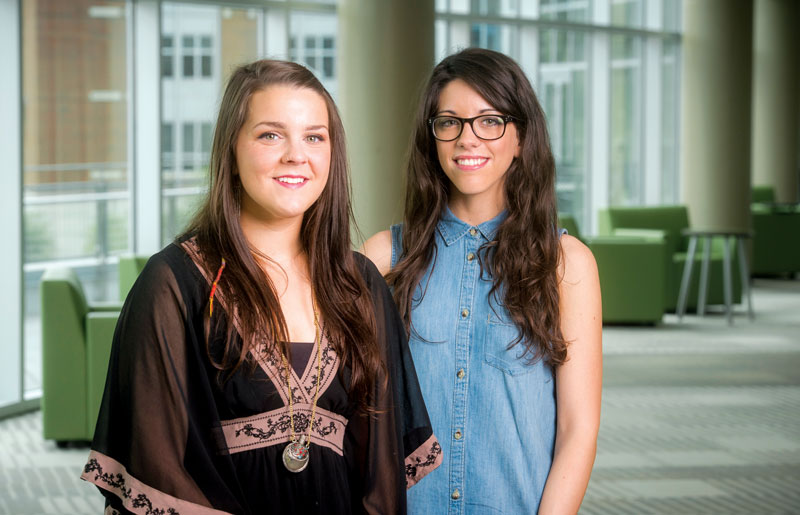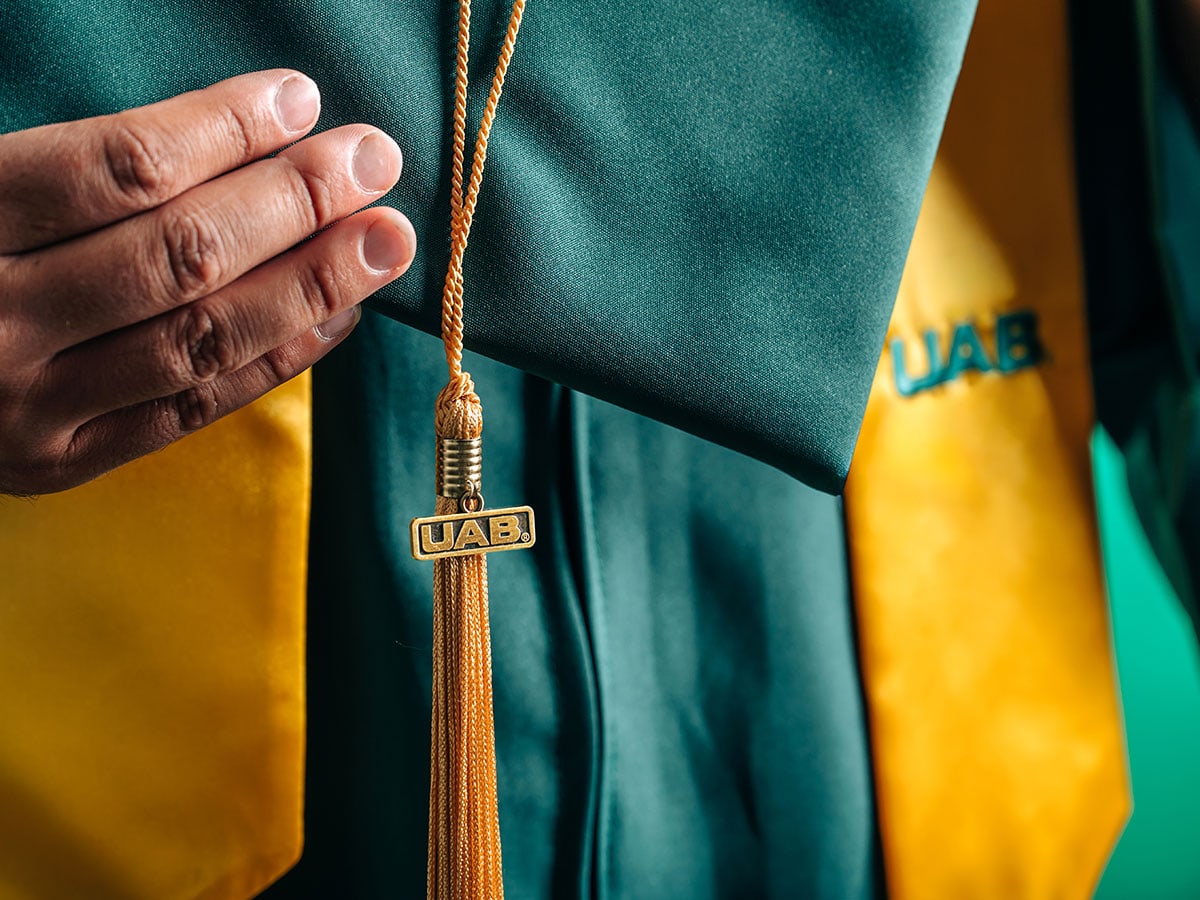Now, centuries later, new evidence debunks that claim. An article from Science News magazine reports on research indicating that the stone “spears” were likely never used as weapons at all, but instead served as general-purpose tools for food preparation and other tasks. And Douglas Fry, Ph.D., chair of UAB’s Department of Anthropology in the College of Arts and Sciences, couldn’t be more excited.
The Easter Island example illustrates a recurring theme in cultural studies—the tendency to overemphasize violence and underestimate the human capacity for peace—he says. “There’s a real bias in the West that war is something that’s always been with us and always will be,” Fry explains. “What we see in anthropology is that’s just not true.”
Those truths are at the heart of a growing emphasis on peace studies at UAB. In addition to a series of anthropology courses that explore concepts such as human empathy, nonviolent conflict resolution, and historic and present-day examples of peaceful societies, students can pursue an interdisciplinary minor in peace, justice, and ecology. UAB also has recruited renowned experts in the field, beginning with Fry, who arrived two years ago. (He also holds an affiliation at Finland’s Åbo Akademi University.) And in September 2016, UAB received approval to establish a new master's degree focusing on peace and human rights—only the second anthropology program of its kind in the United States.
Negative and positive
Kacey Keith, a senior international studies major from Birmingham, sees a special significance to studying peace in her hometown. “This was the center of the civil rights movement,” she points out. “Peace is what Martin Luther King Jr. fought for. He taught that the reason you use nonviolence is that you’re not just trying to change a situation; you’re changing minds.” The opportunity to study peace at UAB is part of that legacy, she says.But fellow students often can be skeptical of the subject. “When some of my friends find out that I have concentrated academically in peace studies, they think I’m a crazy hippie,” admits Bethany Henry, a senior anthropology major also from Birmingham. She tells them that her courses take an objective approach to the subject matter, and that the study of peace is practical as well. “It’s not about some pie-in-the-sky ideal,” she says.
So what is it, exactly? More specifically, how does one teach peace?
Associate professor of anthropology Peter Verbeek, Ph.D., a Dutch-born American who came to UAB last fall, begins with a workable definition of peace itself. “When you ask someone to explain peace, many will describe what we call ‘negative peace’—the absence of violence or aggression,” he explains. “Far fewer people will talk about ‘positive peace’—which is the day-to-day business of maintaining peace. It’s an ongoing process.”
Fry explains it this way: “At the basic level, the concept of positive peace includes having enough food, a roof over people’s heads, and clean drinking water,” he notes. “From there you can ask if people are allowed to participate in a democratic process and have control over their lives politically. Is the justice system operating fairly and effectively? From all of my own reading, I’m convinced that’s basically what we want across cultures—to feel safe and secure—and while war is sometimes sold to us as the only way to maintain that, it’s also possible there are other avenues that are nonviolent.”
Finding role models
Fry has a special interest in researching anthropological “peace systems”—neighboring societies with longstanding traditions of resolving conflicts without war. He says the existence of these systems across cultures and throughout history shows that humans have a greater capacity for peaceful behavior than is commonly thought. “In reality, most of us live every day without participating in or being a victim of murder or even a fistfight,” he notes. “Societies vary in terms of the amount of violence, but every society has ways to deal with conflict that are nonviolent. People discuss problems, or they pack up and leave. They go to mediators. They engage in contests that may be physical but don’t result in anybody being killed. So what we see in anthropology is that there are a lot of alternatives.”Another way to study peace, adds Verbeek, is to observe the behavior of primates. Verbeek, who earned his M.A. and Ph.D. in psychobiology at Emory University, was the first graduate student there to work with Frans de Waal, Ph.D., a pioneer in the study of peacemaking among primates. (De Waal recently spoke about animal intelligence at UAB as the recipient of the 2016 Ireland Distinguished Visiting Scholar Award.) Inspired by de Waal, Verbeek often emphasizes the biology of peace in his own courses. “Prior to de Waal’s work, we studied aggression in animals,” Verbeek says, “but we never took the time to see whether there was a way for animals to make up after a fight and maintain relationships. That has been a breakthrough, learning that animals have ways of reconciling—from physical embracing to grooming to just being in close proximity again and tolerating each other.
“When you see these patterns in nonhuman primates,” he adds, “then maybe that says something about our own abilities or predisposition to be able to be peaceful with each other.”

Leaders in the field
The caliber of professors, the enthusiasm of the students, and the expanding curriculum are quietly making UAB into a hub for the study of peace. Fry points to recent additions to the anthropology faculty and staff—including Verbeek, who is credited with essentially developing the field of peace ethology, or the behavioral biology of peace; research associate Riane Eisler, J.D., D.H.L., who has addressed prestigious diplomatic institutions including the United Nations General Assembly and written the international bestseller The Chalice and the Blade: Our History, Our Future; and visiting associate professor Geneviève Souillac, Ph.D., who has taught about peace in Australia, Finland, and Japan and whose most recent book is A Study in Transborder Ethics: Justice, Citizenship, Civility. Fry himself has published a number of books including Beyond War: The Human Potential for Peace as well as edited War, Peace and Human Nature, a collection of perspectives from leading experts in fields such as evolutionary biology, archaeology, anthropology, and primatology.Fry also is excited that the UAB Department of Anthropology has become the new home of the renowned Peaceful Societies website, first launched 11 years ago by Bruce Bonta (now a UAB research associate in anthropology). “It has an encyclopedia of peaceful societies, news stories and other features, and a large, well-established audience,” Fry states.
Researching rights
Another recent development, the UAB Institute for Human Rights, provides an innovative platform for interdisciplinary collaboration among scholars, educators, students, and activists to research and raise awareness for human and civil rights locally and around the world. Nobel Peace Prize winner Leymah Gbowee, whose nonviolent movement united more than 3,000 women to help end a civil war in Liberia and ensure women's participation in elections, visited UAB to mark the institute's opening. Students Kacey Keith (left) and Bethany Henry learned techniques to cultivate tolerance and manage conflict whether it arises at home, at work, or around the world.
Students Kacey Keith (left) and Bethany Henry learned techniques to cultivate tolerance and manage conflict whether it arises at home, at work, or around the world.Though the institute will collaborate with a wide variety of partners inside and outside the university, its inaugural director, Tina Kempin Reuter, Ph.D., sees natural connections between the institute and peace studies.
“Human rights and peace work hand in hand,” says Kempin Reuter, “so that will be one of the institute’s areas of research and teaching. I’m excited that there is a lot of focus here already on human rights and an emphasis on peace, with a large number of scholars and students who have an interest in this type of topic.” One of those students, Ajanet Rountree, recently became Kempin Reuter’s first intern at the institute.
Kempin Reuter, who is also an associate professor of human rights, peace studies, and international politics in the departments of Government and Anthropology, acknowledges that her subjects can seem so broad—and the challenges at times insurmountable—that it’s easy to become disillusioned. But she firmly believes that research, dialogue, and teaching are fundamental to progress and hopes the institute and its partners will play a large part in that. “Even if we can broaden one student’s thinking or instill the love for human rights, peace studies, or any of those fields, then we can change the world on a very small scale,” Kempin Reuter says. “Maybe that student will go out and join the Peace Corps and make a big impact, or go out and tell other people about what he or she has learned. I try to focus on that. I am an idealist at heart.”
Prepared to lead
Henry and Keith say that pursuing peace studies has already impacted their lives and career goals. Keith is interning with the local branch of the Atlantic Institute, a nonprofit organization working to facilitate dialogue and build bridges among different cultures. “My peace-studies classes have taught me a lot about understanding, utilizing, and establishing tolerance, and what to do when conflicts occur. So I’ve been able to use that knowledge in my internship.”For her part, Henry hopes to go into a related field of research, firmly believing in the importance of peace studies for the next generation of leaders. In the meantime, she believes the lessons she has learned have already had a positive personal effect. “Conflict is not as scary as it once was, because it happens everywhere,” she explains. “Learning how other people and cultures deal with conflict makes it easier to address it myself. And I’m a much happier person because of it.”


